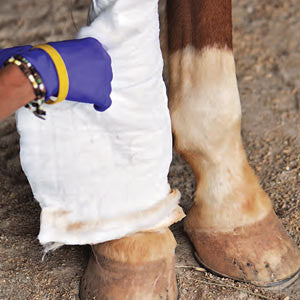What are Splints and how to treat them?
May 08 2016 – Greg Wood


A splint is a strain or tear of the ligaments that bind the splint bone to the cannon bone and usually leads to swelling, inflammation and lameness to the affected leg.
Splints are usually caused by direct trauma to the cannon bone area, with the concussive force from working on hard ground, orthopedic developmental disease, or poor shoeing.
Overworking young horses at high speeds before their bones have become dense and strong is likely to cause splints to develop. Splints usually occur in horses under the age of six.
Splints are characterized by a swelling on the inside, or less frequently, the outside of the front leg between the splint and cannon bone or on the splint bone about three inches below the knee.
Because splint bones have some mobility independent of the cannon bone, tension and strain on the periosteum of the splint bone, where the ligament attaches, can lead to laying down of new bone and inflammation of the area. Known as "blind splints," they are harder to detect because they are between the bones.

Symptoms include:
- Bony swelling
- Warm to touch
- Inflammation
- Mild lameness
Prevention
The best prevention of splints is good horse management and training routines that are in keeping with the horse's developmental age and capabilities.
By preventing traumatic injuries to the legs as much as possible and making sure horses are shod appropriately, many cases of splints can be avoided.
Checking horses routinely before exercise and paying attention to any bumps or swellings on the legs will ensure that horses receive prompt attention, preventing minor conditions from becoming worse.
Treatment
Treatment of splints begins with putting the horse on a reduced workload for several weeks and exercising the horse on soft ground to prevent further calcification due to concussive force.
X-rays should be taken to make sure that no fractures are involved, especially if the splints are caused by direct trauma.
Swelling and inflammation should be relieved with ice packs and pressure bandages. Cortisone injections will help reduce periosteal inflammation. If the interosseous ligament becomes calcified, surgery may be necessary.
Most veterinarians do not recommend surgical removal of the bone growth because it usually does not produce satisfactory results, and, quite often, the bone growth is stimulated by surgery and the splint increases in size.
